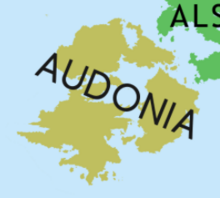Audonia
This article is a work-in-progress because it is incomplete and pending further input from an author. Note: The contents of this article are not considered canonical and may be inaccurate. Please comment on this article's talk page to share your input, comments and questions. |
 | |
| Area | 1,265,709 km2 (488,693 sq mi) |
|---|---|
| Population | 2,856,697,318 (2028)wip |
| Population density | 2,426/km2 (3,904/sq mi)wip |
| Demonym | Audonian |
| Countries | 27 |
| Dependencies | 3 |
| Languages | Arabic, Pukhtu, Burgoignesc, and others |
| Time zones | UTC-3:00 to UTC+2:00 |
| Largest cities | Largest urban areas: Peshawar Amenhotep Matsova |
Audonia is a continent. It is known as the heartland of Islamic civilization. It is comprised of three major areas, sometimes referred to as subcontinents.
Audonia has a rich history dating back to some of the first agriultural civilizations in the world being established on the continent. From the beginning of the Neolithic Revolution until around the first milennia BC, Audonia was one of the most populous continents and was the richest. Although later eclipsed by the growth of the Occident in terms of power, Audonia remained an extremely wealthy region for centuries to come. The growth of the Occident had the effect of increasing Audonia's relative wealth, as it provided a conduit for valuable trade goods heading west from Alshar. Audonia in antiquity was a place of many different cultures, societies, and religions, and for a time was considered the "world's melting pot." Modern Audonia is considered to have begun with the rise of the Oduniyyad Caliphate and Islam in the 7th century, an event which would define modern Audonia and play a pivotal role in world history. The gradual collapse of the Caliphate beginning in the 11th century and complete by the 16th century briefly restored Audonia as a place of cultural interchange and wealth along with significant state competition and warfare. The arrival of Bergendii and other Occidental influences led to a general decline in Audonia as colonialism gradually diminished Audonia's economy and prestige. By the late 20th century, most of Audonia had reestablished a degree of independence from the Occident, but significant colonial holdings and influenced states remain. By this time, the continent had become home to many proxy wars related to the Occidental Cold War, and competing Occidental influences continue to play a major role in political divisions throughout the continent.
Name
Audonia takes its present name in most Occidental languages from the Oduniyyad Caliphate.
Extent
Regions
Siphost
The northern island of Audonia.
Siphost emerged from antiquity as the poorest portion of Audonia as most major trade routes to the continent were far to its south. Despite not enjoying the wealth of the rest of the continent, Siphost retained a strong martial character which allowed it to remain independent of the Oduniyyad Caliphate until the middle portion of the 8th century.
Daria
The southeastern island of Audonia.
Daria is considered to be a melting pot of influences from the rest of Audonia and Alshar, with which it shares much of its history and some of its culture.
XXX
The southwestern island of Audonia.
This subcontinent is closely associated with Islam, as the two holiest cities in that religion - as well as its historical heartland - exist here. Consequently, most of the nations on this subcontinent are large Muslim majority countries. Audonian Christianity also originated here with a minority of countries having bare Christian majorities, though most countries have at least a pre-Islamic Audonian Christian heritage.
Countries, dependencies, and other territories
Battganuur
Bulkh
Umardwal
Yanuban
United Audonian Emirates
 Zaclaria
Zaclaria- Antilles
- Chaukhira
- Alcairet
- Salarive
History
Audonia established ties with the Occident in the earliest part of Antiquity, as advanced Audonian sailmaking techniques allowed Audonians to sail west across the Sea of Istroya; the return trip was much more difficult due to prevailing winds and was only mastered later in Antiquity. Through its connections east with Alshar and west with the Ancient Istroyan civilization, Audonia became a wealthy trade hub which controlled the flow of both goods and knowledge between the far west and east. Audonia during antiquity became a place of relative diversity, and the lack of a single great empire in the continent during the period meant military, cultural, and economic competition between its many polities and city-states flourished.
The Oduniyyad Caliphate united most of the continent, excepting Siphost, by the end of the 7th century.
The Audonian Golden Age was an era of unprecedented cultural and scientific flourishing in Audonia.
Audonia spent much of the Age of the Sail as the object of commercial and imperial competition between Burgundie and Kiravia, in which Burgundie ultimately prevailed.